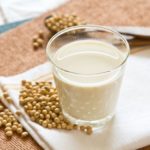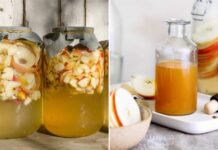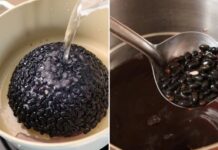Have you ever bought a watermelon or a mango that turned out to be tasteless? If so, you’re probably worried about how to choose the best fruits for your family from now on. Don’t worry, I’ll let you in on some tips for selecting delicious and safe fruits.
1 How to Choose a Watermelon
Selecting a juicy watermelon is not as difficult as you may think. The simplest way is to hold the watermelon about 5cm away from your ear and tap it; if you hear a hollow sound, it’s a good one.
A ripe and safe watermelon usually has a smooth, shiny skin with distinct patterns and sharp veins, and a slightly yellow bottom. On the other hand, watermelons that have been injected with chemicals to speed up ripening may have a fuzzy layer, a dark skin, and dull patterns because they are not yet ripe.
There are many other characteristics of watermelons that can help you choose a good one. For more tips, refer to the image below:

2 How to Choose a Mangosteen
When selecting mangosteen, look for those with fresh, light yellow, and glossy skin. Avoid dull and unevenly colored mangosteens as they are not likely to be tasty.
Additionally, choose mangosteens with large, soft spines, and wider spacing between the spines for the sweetest fruit.

3 How to Choose a Papaya
Go for papayas that have yellow-colored stems as this indicates natural ripeness. Also, look for long papayas that feel heavy for their size, with sticky stems. These papayas tend to be sweeter, less seedy, and have thicker flesh.
Naturally ripened papayas may have a thin layer of white mold and some small black spots or indentations on their skin. Avoid papayas with shiny, hard skin, even if the outer layer has turned yellow.

4 How to Choose a Mango
Look for mangoes with smooth, shiny skin, free from scratches and dark spots. You can also tug on the mango’s stem and smell it; if it’s fragrant and has sap, it’s fresh and free from preservatives.

5 How to Choose an Apple
Apples are a familiar fruit to many families. When buying apples, look for those with a deep red color and an even tone. Also, look for apples with small white spots on their skin.
Choose apples with fresh, unwithered stems.

6 How to Choose a Pomelo, Orange, or Tangerine
The selection methods for these three fruits are quite similar. Look for thin, shiny, and bright green skins, but not too green.
To check the thickness of a pomelo’s skin, gently tap the surface with your fingernail. If you hear a ‘pop pop’ sound, the skin is thick; if you hear a ‘crack crack’ sound, the skin is thin.
For oranges and tangerines, gently squeeze the skin to see if any oil is released. If so, they are fresh. Also, look for a slight indentation around the stem, which indicates a juicy fruit.

7 How to Choose a Durian
Durian is a fruit that many people love for its unique smell and delicious taste. To choose a good durian, look for those with a strong, pleasant aroma, easy-to-peel skin, golden-yellow flesh, and a creamy, soft texture.
You can also knock on the durian with a knife; if it sounds hollow, it has thick flesh and flat seeds. If it sounds more like a ‘bong bong,’ it likely has many seeds and isn’t as tasty.
Durian treated with chemicals tends to have lighter yellow flesh, a drier texture, and a milder taste. The segments of chemically treated durian are also harder to separate.

8 How to Choose a Banana
Like apples, bananas are a popular choice for many families. They are known to have several health benefits.
To choose bananas that haven’t been soaked in chemicals, look for bunches with unevenly ripened bananas (some green, some yellow) and some black spots or dark pink marks. Avoid bunches with evenly ripened, bright yellow bananas.
You can also taste a banana when buying. Naturally ripened bananas will be sweet and soft, with a natural fragrance. Chemically treated bananas tend to be astringent, slightly hard, and sour.

9 How to Choose a Dragon Fruit
It’s easy to be misled when buying dragon fruit. Many people think that the greener the dragon fruit, the better. However, you should look for heavier dragon fruits with darker skin and green but not overly green scales. The darker the skin, the sweeter and more delicious the fruit.

10 How to Choose Grapes
When buying grapes, look for clusters with a powdery coating on the fruit, as this indicates freshness. Avoid grapes that are soft, have an unusual smell, or have spotted fruit.

These tips should help you shop for fruits confidently, avoiding spoiled or chemically treated produce. There are many more tips and tricks to help you choose the best fruits, which I will introduce in future articles. Feel free to ask any questions in the comments, and I’ll be happy to help!
Showcasing Beauty with a Natural Look
Today, it is a widely-held belief that the kitchen contains an abundance of natural remedies for perfecting your beauty routine. From honey to cucumbers, oranges and avocados, to almonds and papaya, some of the ingredients found in the pantry can give you fresh, glowing skin without the need for expensive cosmetics.







































